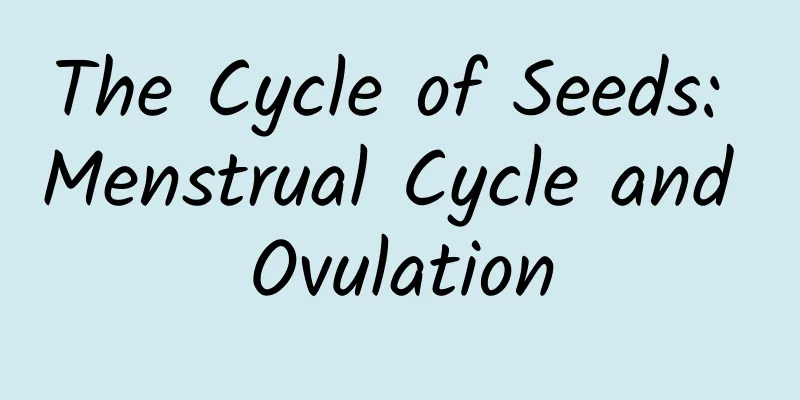The Cycle of Seeds: Menstrual Cycle and Ovulation

|
The Cycle of Seeds: Menstrual Cycle and Ovulation Menstruation is the periodic shedding and bleeding of the endometrium that occurs with the cyclical changes of the ovaries at a certain age. It is a natural phenomenon in the female physiological cycle. Because it generally takes one lunar month as a cycle, it is often unchanged and has a fixed period, so it is called "menstruation", also known as "monthly affairs", "monthly flood", "monthly water", and "menstrual water". Li Shizhen of the Ming Dynasty said in the entry of "Compendium of Materia Medica: Women's Monthly Water": "Women are yin, and are mainly blood. Their blood corresponds to the moon above and the sea tide below. The moon waxes and wanes, and the tide has ebb and flow. Menstruation occurs once a month, which is consistent with it, so it is called monthly water, monthly letter, and menstruation." Menstruation is a manifestation of female physical maturity, a symbol of fertility, and a very important old bestie for a woman. The menstrual cycle of women starts from the first day of menstrual bleeding and ends on the first day of the next menstrual bleeding. The menstrual cycle has a distinct monthly rhythm, generally 28-30 days, and its length varies from person to person. The 7 days before and after 28 days are all within the normal range. The regularity and periodicity of menstruation are manifested in the normal cycle, menstrual period, menstrual volume, menstrual color and menstrual quality of menstruation. The duration of each menstrual period is called the menstrual period, which is generally 2-7 days, and most of them are 3-5 days. The total amount of bleeding during each menstrual period is called the menstrual volume, which is normally 30-80ml, with individual differences. Menstrual blood contains blood, endometrial sloughing, cervical mucus, vaginal secretions and sloughed vaginal epithelial cells. The menstrual color is dark red, lighter at the beginning, brighter when the amount is large, and gradually lighter when it is about to be clean. The menstrual quality is moderately thin and thick, does not coagulate, and has no odor. The menstrual cycle is divided into menstrual period and non-menstrual period, and the non-menstrual period is further divided into follicular phase, ovulation phase and luteal phase. The menstrual period lasts for 3-7 days. It refers to the process of shedding and expelling the endometrium if the egg is not fertilized or the embryo is not successfully implanted within two weeks after ovulation. Due to the decrease in estrogen and progesterone levels in women, the blood supply to the endometrium decreases. At the same time, the prostaglandins produced by the uterus cause spasms of the spiral arteries and contraction of the uterine muscle layer, which eventually leads to necrosis and shedding of the endometrium and its blood vessels, forming menstrual blood. After the menstrual period, the non-menstrual period begins. The follicular phase is also called the proliferative phase and lasts about 10-14 days. As the follicles grow and mature, the ovaries secrete more and more estrogen, which causes the endometrium to grow again. The ovaries secrete the hormone progesterone to maintain the growth and thickening of the endometrium, and the uterine glands also grow accordingly. Ovulation is a critical period of the menstrual cycle, usually around the 14th day of each menstrual cycle, but may vary depending on individual differences. During ovulation, the egg is released from the ovary, enters the fallopian tube, and waits for the arrival of sperm in the ampulla of the fallopian tube and successfully combines with it. The luteal phase is the longest phase of the menstrual cycle, lasting about 14 days. After ovulation, the follicle turns into the corpus luteum, which secretes progesterone that acts on the endometrium, causing endometrial blood vessels to proliferate and become congested, and uterine glands to secrete mucus, all in preparation for the successful implantation of the fertilized egg. If the egg is not fertilized or the embryo is not successfully implanted after ovulation, it will enter a non-progesterone secretion cycle, where the endometrium begins to shed and discharge, forming a new menstrual period. This process will repeat until women enter menopause and menstruation stops. The first menstrual period in a woman's life is called menarche, which is a sign that a woman is gradually maturing and has fertility. The age of menarche varies depending on individual conditions, family life, environmental climate, regional differences, genetics and many other factors. Most menarches are between 13 and 15 years old, but can be as early as 11-12 years old or as late as 16 years old. Women have menstruation for about 35 years in their lifetime, and usually stop at around 49 years old. The last menstrual period is the sign of menopause, and the cessation of menstruation for more than one year is called "menopause" or "absence of menstruation". Menopause means that the ovaries no longer ovulate, and women are no longer fertile. The age of menopause is generally between 44 and 54 years old. It can be as early as 40 or as late as 55 years old, depending on factors such as genetics, physical constitution, and nutrition. |
>>: How much do you know about the "primordial power" of musculoskeletal ultrasound?
Recommend
What is the cause of brown discharge after menstruation?
Abortion surgery can cause harm to women both psy...
What should I do if my stool is dry during confinement?
There are several groups of people who are partic...
There are horizontal lines on the bridge of the nose between the eyes of women
If we do an action, such as frowning, often enoug...
My child sweats profusely all the time, what should I do?
The character for sweat has “水” on the left and “...
Is it normal to have frequent bowel movements during the eighth month of pregnancy?
Pregnancy is very hard, especially in the late st...
What kind of clothes are better to wear during confinement in summer?
Summer is the peak fertility season, because babi...
How many types of vaginas are there in women?
A woman's vagina is a complex structure. Many...
There are blood clots like meat in menstruation
Menstrual blood clots require not only medication...
What is the best way for women to lose weight?
When girls get together, the topic they like to t...
What to eat for uterine cold?
The biggest threat to women's health is gynec...
What is the cause of anal pain in pregnant women?
Giving birth is not an easy thing. It is a challe...
Ovulation test paper weak positive in non-ovulation period
Many women have weak fertility, so they need to a...
How to treat female seborrheic alopecia with traditional Chinese medicine
Hair affects a person's temperament and can a...
Why can't you eat eggplant when you are pregnant?
Green beans are a kind of vegetable and fruit tha...









